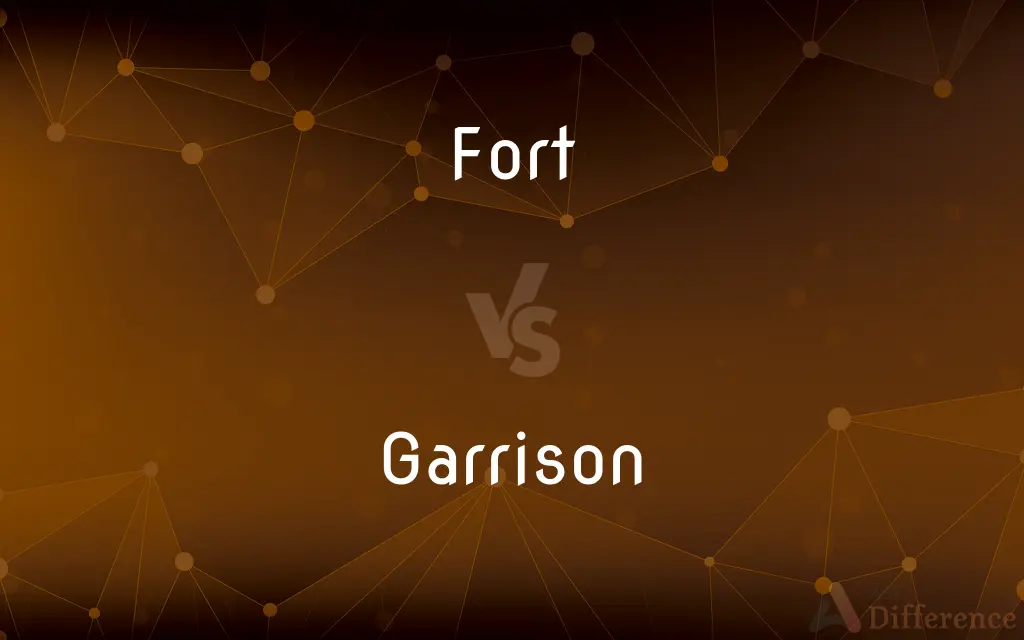Fort vs. Garrison — What's the Difference?
By Fiza Rafique & Urooj Arif — Updated on April 1, 2024
A fort is a fortified military encampment designed for defense, typically a permanent structure, while a garrison refers to the troops stationed at a fort or other outpost.

Difference Between Fort and Garrison
Table of Contents
ADVERTISEMENT
Key Differences
A fort is essentially a military stronghold, often surrounded by walls, ditches, and other defenses designed to protect against enemy attacks. These structures have been used throughout history as defensive positions, offering soldiers a secure base from which to operate. In contrast, a garrison is not a structure but a group of soldiers. The term specifically refers to the troops that are stationed in a fort, fortification, or territory to defend it. The primary purpose of a garrison is to maintain a military presence in a strategic area, whether for defensive purposes or to assert control over a region.
Forts are built with the intention of enduring sieges and attacks, incorporating features like thick walls, bastions, and reinforced gates to withstand bombardment and prevent enemy entry. They are often situated in strategic locations, such as borders, coastlines, or river crossings, to control movement and protect important assets. On the other hand, garrisons play a crucial role in the operation of these forts, providing the manpower necessary for their defense, maintenance, and daily function. The size and composition of a garrison can vary greatly depending on the strategic importance of the location and the perceived threat level.
In terms of function, a fort serves as a physical barrier and a base of operations for military activities, including training, storage of arms and supplies, and as a command center. It is a symbol of military strength and a deterrent to potential aggressors. Conversely, a garrison is dynamic, capable of responding to threats, conducting patrols, and executing military operations as needed. The presence of a garrison ensures that the fort remains an active component of a country’s defense strategy rather than just a passive structure.
The relationship between a fort and its garrison is symbiotic. Without a garrison, a fort would be little more than an empty shell, unable to fulfill its defensive purpose. Similarly, a garrison without a fort or similar fortification lacks the enhanced defensive capabilities and support structure that such a facility provides. Together, they form a comprehensive defense mechanism, with the fort offering protection and logistical support to its garrison, which, in turn, provides the necessary force to defend and operate the fort effectively.
While the concept of a fort has evolved over time, with modern military strategy often favoring more mobile and flexible defense mechanisms, the fundamental principle of a fortified position remains relevant in certain contexts. Meanwhile, the role of the garrison has also adapted, with modern troops being highly mobile and capable of rapid deployment to various locations, not limited to traditional forts but also including bases, camps, and other strategic positions as dictated by contemporary military needs.
ADVERTISEMENT
Comparison Chart
Definition
A fortified military structure for defense.
Troops stationed to defend a fort or territory.
Purpose
To protect against attacks and control areas.
To maintain a military presence and defense.
Composition
Buildings, walls, and defensive works.
Soldiers and military personnel.
Function
Physical barrier and base of operations.
Active defense and military operations.
Relationship
Provides protection and support to the garrison.
Gives purpose and function to the fort.
Strategic Value
Fixed; based on location and construction.
Mobile; depends on troop strength and readiness.
Historical Role
Defensive stronghold against sieges.
Provides manpower for defense and control.
Compare with Definitions
Fort
A fortified military installation for protection against attacks.
The ancient fort stood guard over the harbor for centuries.
Garrison
A body of troops stationed at a fort or outpost.
The garrison was on high alert for possible attacks.
Fort
Characterized by robust defensive structures.
The fort's thick walls have withstood numerous sieges.
Garrison
Plays a key role in military operations.
The garrison's swift response repelled the invaders.
Fort
Symbolizes military strength and security.
The fort was a reassuring sight for the city's residents.
Garrison
Reflects a nation's military reach and presence.
The overseas garrison demonstrated the nation's commitment to its allies.
Fort
Serves as a military command center.
The commander issued orders from the heart of the fort.
Garrison
Responsible for a territory's defense.
The local garrison patrolled the borders regularly.
Fort
Often located at strategic points.
The fort at the river's mouth controlled access to the interior.
Garrison
Can be deployed or withdrawn as needed.
The garrison was reinforced in anticipation of conflict.
Fort
A fortified building or strategic position
The city was guarded by a ring of forts
Garrison
Garrison (from the French garnison, itself from the verb garnir, "to equip") is the collective term for any body of troops stationed in a particular location, originally to guard it. The term now often applies to certain facilities that constitute a military base or fortified military headquarters.
Fort
A fortified place or position for the stationing of troops.
Garrison
A military post, especially one that is permanently established.
Fort
A permanent army post.
Garrison
The troops stationed at a military post.
Fort
A fortified defensive structure stationed with troops.
Garrison
To assign (troops) to a military post.
Fort
Any permanent army post.
Garrison
To supply (a post) with troops.
Fort
(historical) An outlying trading-station, as in British North America.
Garrison
To occupy as or convert into a military post.
Fort
A structure improvised from furniture, bedding, etc., for playing games.
The kids built a fort out of chairs and pillows.
Garrison
A permanent military post.
Fort
To create a fort, fortifications, a strong point, or a redoubt.
Garrison
The troops stationed at such a post.
Fort
A strong or fortified place; usually, a small fortified place, occupied only by troops, surrounded with a ditch, rampart, and parapet, or with palisades, stockades, or other means of defense; a fortification.
Detached works, depending solely on their own strength, belong to the class of works termed forts.
Garrison
(allusive) Occupants.
Fort
A fortified military post where troops are stationed
Garrison
A military unit, nominally headed by a colonel, equivalent to a USAF support wing, or an army regiment.
Fort
A fortified defensive structure
Garrison
To assign troops to a military post.
Fort
Gather in, or as if in, a fort, as for protection or defense
Garrison
To convert into a military fort.
Fort
Enclose by or as if by a fortification
Garrison
To occupy with troops.
Fort
Station (troops) in a fort
Garrison
A body of troops stationed in a fort or fortified town.
Garrison
To place troops in, as a fortification, for its defense; to furnish with soldiers; as, to garrison a fort or town.
Garrison
A fortified military post where troops are stationed
Garrison
United States abolitionist who published an anti-slavery journal (1805-1879)
Garrison
The troops who maintain and guard a fortified place
Garrison
Station (troops) in a fort or garrison
Common Curiosities
Can a fort function without a garrison?
While a fort can physically exist without a garrison, its effectiveness as a defense mechanism significantly diminishes without troops.
Are all military bases considered forts?
Not all military bases are forts; forts are specifically designed for defense, whereas bases can serve a variety of purposes, including training, logistics, and operations headquarters.
What does a garrison do?
A garrison consists of troops that defend the fort, conduct military operations, and maintain a presence in the territory.
What is the difference between a fort and a fortress?
A fortress is generally larger and stronger than a fort, often intended to protect a whole city or a large area, whereas a fort is usually smaller and protects a specific point.
What materials are used in fort construction?
Historically, forts were constructed from materials like earth, stone, and wood, evolving to incorporate concrete and steel in modern fortifications for enhanced durability.
Are there examples of forts that have never been taken by force?
Yes, there are historic forts known for their impregnability, having never been successfully besieged or taken by force, thanks to their strong defenses and strategic locations.
How do forts and garrisons differ in modern military strategy?
Modern strategy often emphasizes mobility, with garrisons able to move and respond flexibly, while forts are fixed structures with specific, sometimes less central roles.
What is the primary function of a fort?
A fort serves as a fortified base for defense against enemy attacks and a control point over strategic areas.
How have forts evolved with modern warfare?
In modern warfare, the role of static forts has diminished in favor of more mobile and technologically advanced forms of defense, though some forts still serve as military centers or training facilities.
What role do garrisons play in peacekeeping missions?
In peacekeeping missions, garrisons often provide security, aid in reconstruction, support local authorities, and help maintain order.
How do cultural perceptions of forts and garrisons vary by country?
Cultural perceptions can vary significantly, with forts and garrisons symbolizing military strength, heritage, and historical significance in different countries, often reflected in their preservation as historic sites or monuments.
How is a garrison size determined?
The size of a garrison is typically based on the strategic importance of the location, the potential threat level, and the capacity of the fort or facility.
Can garrisons be found outside of forts?
Yes, garrisons can be stationed in various types of military installations or territories, not just traditional forts, including bases, outposts, and strategic locations.
How does technology impact the function of forts and garrisons today?
Technology enhances the defensive capabilities of forts with advanced surveillance and weapons systems, while also enabling garrisons to be more mobile and efficient in their operations.
Do garrisons engage in offensive operations?
While primarily for defense, garrisons can engage in offensive operations as needed, depending on their orders and the tactical situation.
Share Your Discovery

Previous Comparison
Cajole vs. Coerce
Next Comparison
Chunk vs. BunchAuthor Spotlight
Written by
Fiza RafiqueFiza Rafique is a skilled content writer at AskDifference.com, where she meticulously refines and enhances written pieces. Drawing from her vast editorial expertise, Fiza ensures clarity, accuracy, and precision in every article. Passionate about language, she continually seeks to elevate the quality of content for readers worldwide.
Co-written by
Urooj ArifUrooj is a skilled content writer at Ask Difference, known for her exceptional ability to simplify complex topics into engaging and informative content. With a passion for research and a flair for clear, concise writing, she consistently delivers articles that resonate with our diverse audience.















































